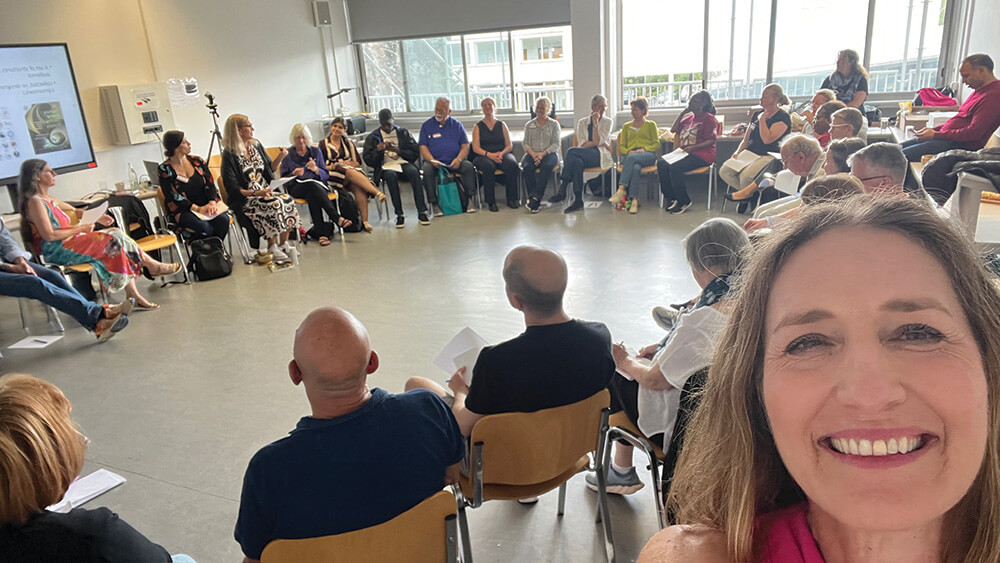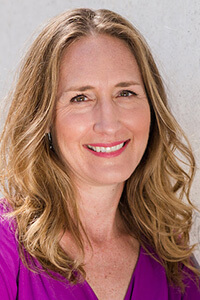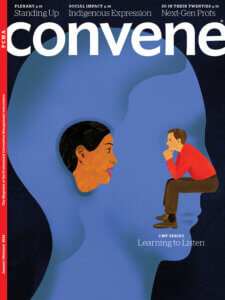
Structured listening activities, including listening circles, helped International Listening Convention (ILA) participants feel heard — and improved their listening skills.
Facing the context of unrest in certain parts of the globe and challenges like AI, the need for sustaining best listening practices and working out better solutions for “a sustainable future is more important now than ever before,” reads a message promoting the 45th International Listening Convention (ILA), June 12-16, 2024, in Bloomington, Minnesota.
“Listening is a skill that we need to learn now,” Raquel Ark, a communications facilitator and ILA’s president, told Convene, but, she added, there is only a “small minority” doing it. Count ILA members from 25 countries — health-care providers, educators, students, lawyers, business managers, entrepreneurs, hospitality workers, spiritual leaders, communication trainers, researchers, artists, scientists, engineers, and social workers — in that minority. “It’s one of the most multidisciplinary fields,” Ark said. “The common ground is that we’re all interested in advancing this topic. The research in listening has increased tremendously. The more we learn, the more we realize what we don’t know yet.”

Raquel Ark
Ark calls listening a “power skill” rather than a hard or soft skill. “You can have power by listening and you can have power by not listening,” she said. “If I don’t listen to you, I’ve got autocratic power because you’re not as important as I am, but as a leader, if I listen to you, then my prestige power goes up, and people are inspired by me. That’s what the research is showing.”
Joint Effort
Last summer, ILA held its first-ever hybrid convention in Mainz, Germany, and focused on making it both more collaborative and less of a one-off event — demonstrating that the association practices what it preaches. “We were listening to our membership a few years ago,” Ark said, “and one of the things that they were asking for was to be able to connect and collaborate more.” So those two elements were woven into the 2023 convention design from the early planning stages — including calls for session proposals. “We said, ‘If you connect and collaborate with someone else in the organization, or with at least one or two other people, the chance that your proposal will be accepted is higher than if you do it by yourself.’ That causes people with ‘my’ ideas to come together and come up with ‘we’ ideas. They’re learning from each other.”
ILA also conducted three online sessions prior to the conference for both digital and in-person registrants to meet. “We had one session where people got to analyze their listening personalities and then talk about it — they got to learn about themselves. Another session was about how to create connection — it was about putting people in pairs and using a specific process to listen to each other. Then the third one was a listening circle — listening in the collective. We wanted people to start listening to each other before they even got to the convention.”
Ark said that it’s crucial to get people to connect in twos as soon as possible during the event, which ILA facilitated by setting up a buddy system online. “The factor that has the most impact on whether listening occurs is who they’re listening to, and the dyad is what the scientists talk about,” she said. If you can encourage participants “to mix and match in twos,” she added, “the chances are better that the connection and trust will start. Then, people are more likely to speak up and listen to each other in groups.”
ILA’s 2023 convention was intimate — about 70 people in person and 30 online. For events with large numbers of attendees, Ark recommends putting people into cohorts — groups of around 30 people “who meet at the beginning and at the end of each day, like a check-in and a checkout” and who participate in off-site events together, with one or two leaders designated for each cohort.
On-Site Design
ILA intentionally built in more time between sessions to allow for more connections to take place in Germany, but it still wasn’t enough, Ark said. Because people connected and collaborated before and during the event, there was greater discussion after the sessions concluded — presenters “wanted to learn from the people who were attending,” she said. “The listening was going back and forth — people were asking questions or talking about their experience that also made presenters think further than what they had thought of before. They would’ve liked to keep going.”
For the future, Ark thinks that setting up listening circles and similar structured listening activities between sessions, in addition to organic networking, is a good idea. “Listening circles are very simple, very easy, very powerful. Then everybody’s voice is heard. Nobody has to speak if they don’t want to. They can just listen if they want to,” Ark said, “but everyone’s included. And their listening does impact the group — having listeners helps people speak better.”
In addition to listening circles, ILA’s convention featured liberating structures, which are “beautiful for creating non-hierarchical collecting type of ways of getting people to interact,” Ark said. One involved having attendees write down “their boldest idea for ILA” on a piece of paper anonymously, which got passed around and then voted on — from that activity, she said, “we realized it’s time for us to get a community platform going.”
To improve their presentations, an ILA member and former TEDx coach worked with two keynote speakers at the same time, which made their sessions “much more authentic,” Ark said. And because they practiced their presentations together, they “evolved from their initial ideas” — plus, they felt supported by each other, she added. It’s common for presenters, Ark said, to want to provide as much information as possible, “but by packing it in, is that making it easy for the listener?
It’s too much for us to take in.” ILA’s session speakers were advised that if they had 10 things they wanted to say, to pick one or two, and to save the rest for interactive conversations following their presentation. “That’s where the gold is — share something that makes people curious and gives value, and then find a way to get people to interact,” she said. Panel sessions also skewed toward the audience conversation portion. Ark suggested that you could enhance that with some structure: Put people into small groups to talk about what was discussed, and then go back to the panelists with questions from the groups.
‘Creating the Glue’
“It’s the energy — what you don’t see — that connects people” at events, Ark said. “If in your event you can create moments of people listening to each other, that’s part of creating the glue.”
While you can’t force listening at your event, you can try to “set the conditions,” she said, by creating an awareness, using the word “listening” in your communications, and offering structured listening activities. “If you want people to feel listened to, put them into pairs or small groups. It’s about building trust and belonging at the event.”
Give participants in groups of three roles to play, she suggested: One person is designated the listener, another a speaker, and the other the observer, and then they switch roles. The listener is instructed not to fix the problem, give ideas, or judge — just to reflect back what they heard.
“Often, we don’t realize how powerful it is when we listen to someone how it helps them to speak better, to think better, to work better,” Ark said. “What worries me the most about when people are not listening to each other is it’s taking away from our critical thinking. The listening research is showing that if you listen well when someone is talking, eventually, instead of persuading you, they will start to relax, they’ll feel safe, and then they’ll start expressing them- selves.” What follows next is they “become less extreme in their thought processes,” she said. “This is what listening is doing.”
ILA’s efforts to think about its 2023 convention as being a “spark” for continued collaboration have paid off, Ark said. There has been “a ripple effect” with participants sharing that they are “writing articles together, working on a program together, or doing research together” with those they met in Germany.
And ILA continues to refine how to create opportunities for connection and collaboration at its convention. “By bringing research and education professionals together so that they can learn from each other, or how can research and business come together so that researchers get more into businesses to do their research, and businesses can learn from research,” Ark said, “I would say that’s the phase that we’re starting now.”
Michelle Russell is editor in chief of Convene.
On the Web
Learn about Liberating Structures, used to enhance relational coordination and trust and foster lively participation in groups of any size, at liberatingstructures.com, which offers blueprints for 35 different approaches.
 Listen Up
Listen Up
This article and those listed below are part of Convene’s January/February 2024 issue cover and CMP Series story package.
